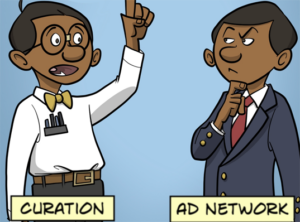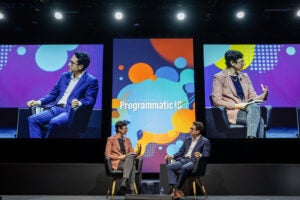 The New York Times’ new Flex Frame ads are among the first component-based ads deployed in the wild with the help of Google tech.
The New York Times’ new Flex Frame ads are among the first component-based ads deployed in the wild with the help of Google tech.
The ads adjust their look and feel according to screen type and page environment. Expect other publishers to follow with their own versions over the next year.
The Flex Frame ads can look like a close cousin of banner ads, although on mobile they extend to the edge of the screen. But they perform better: The Times sees double the click-through rates for its Flex Frame ads.
Their underlying tech is also far different from a banner’s. Instead of submitting 300x250s and 728x90s to publishers – formats that are being phased out – advertisers send text, images and logos, which publishers arrange to look native on their sites.
In essence, advertisers send one ad that’s infinitely customizable.
The ads help publishers like the Times compete with Facebook, Snapchat and other platforms that create proprietary native ad units that feel natural for their environments compared to banner ads.
The Flex Frame ads “adopt the form and function of the Times’ website but also tell a marketer story at the same time,” said Rachael Savage, VP of ad operations and platform strategy at the Times.

Because of the “large canvases,” the Times expects to see brand advertisers flock to the format.
The Daily Beast, eBay, Grupo Expansion in Mexico, Aller Media in Sweden and Trovit in Spain are also building custom ad experiences using Google’s component-based ads. Gannett expects to roll out its version of the ads in November.
But in order for these ads to scale, they need to look custom without requiring ongoing custom work.
“Flexible [custom] units can be difficult to operationalize,” said Jeff Burkett, VP of ad innovations at Gannett. “Fewer people buy them because they are custom.”
So the native ads need to work programmatically, which is still a work in progress. The Times is testing private marketplaces that run with Flex Frame ad creative.
Google plans a “big push in 2017 … for publishers to do programmatic native ads,” said Google group product manager Josh Cohen, who works on DoubleClick for Publishers and the Google Ad Exchange.
Google’s market power may convince buyers to experiment with native formats.
“Google native sends a market-making message,” Savage said.
Publishers still have an opportunity to differentiate themselves in their execution of the ad format.
“How we render those core assets [such as headline, image and logo] to build the Flex Frame in a Times way makes us different from another publisher,” Savage added.
How swiftly publishers adopt the Google-enabled format is anyone’s guess. Google launched the tech for buyers just a few months ago. Since many publishers have road maps for product improvements, it will take time to roll out changes, Burkett noted.
Questions also remain regarding how the ads will fit into the proposed changes to IAB standard ad units. The new standards just entered a public comment period, and Google’s Cohen wouldn’t speak about how the ads might comply with the new standards. When delivered programmatically, the native ads do support the openRTB protocol, according to Google.
External forces, like the rise of ad blocking and shift to mobile, may prompt swifter adoption as publishers seek deliver better ad experiences to readers.
“This concept is going to help publishers respond to the way advertising needs to morph in the age of ad blocking,” Burkett said.













